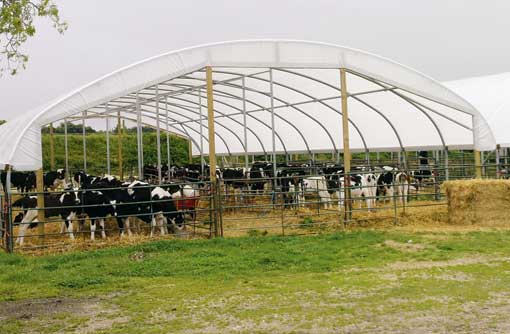Polytunnels are plastic fantastic for livestock

Livestock farmers are increasingly considering polytunnels as an affordable system of housing for their animals, as it provides a high standard of accommodation at a competitive price.
And with some farmers still using the same steel-frame structures purchased 25 years ago – not to mention the up to five-year guarantee leading manufacturers are offering on the PVC outer layer – the polytunnel system is now established as a well-proven permanent housing system.
“The polytunnel system provides a light and airy environment that creates a natural living space for livestock, but with all the benefits of being protected from the elements – and that’s just as relevant for those who work in it as well as the stock,” says Alasdair McGregor of McGregor Polytunnels, Ropley, Hampshire.
TYPES OF POLYTUNNEL
But he urges farmers to make sure they are fully aware of the types of polytunnel available to ensure they invest in the correct structure for their stock and the location they have in mind.
“What’s known as the Spanish-type polytunnel – the basic structure most widely used for fruit growing – isn’t suitable for livestock. To describe the many designs and opportunities presented by the polytunnel system for livestock it’s probably more appropriate to refer to them as ‘curved roof’ livestock houses,” says Mr McGregor.
While siting is important, modern polytunnels for livestock have benefited from the latest design technology to improve strength and stability.
“Siting isn’t as critical as some farmers think, although it always has to be carefully considered,” says Mr McGregor.
Because of the curved roof design, ventilation is often considered better in a polytunnel than in a conventional building because the air tends to flow from one side of the building to another, say manufacturers. Ridge-vents are also an option offered by some companies.
SHEEP
The use of polytunnels for lambing or in-wintering ewes has made them increasingly popular among sheep producers. The recommended stocking rate for sheep is based on an allowance of 1.1sq m of lying space a ewe or 1.5 sq m for a ewe with twins. But polytunnel systems for pigs, cattle and poultry are now widely used.
The base layer in a polytunnel depends on the stock being housed. A structure used for sheep can successfully use a grass base without “scree” or stone being laid. “The light comes through the roof and it dries out the ground. The UV light coming through kills bacteria and eventually the ground tends to crack and drains very well.
“If you scree it you will just end up dragging out the material every time you clean out the building,” says Mr McGregor.
Prices cover a wide range depending on size and design. A 10m x 50m polytunnel for sheep with gutters from a leading polytunnel manufacturer was quoted at around £8,500 – that’s less than £20 a sq m. A 16ft x 30ft sheep house from another company based on a steel framework of 50mm diameter and 800 gauge/200 micron polythene cover, would cost £1,505 ready for assembly.
CASE STUDY: Ed Friend, Nantwhich, Cheshire
Cheshire vet and dairy farmer Ed Friend is using polytunnels as part of a new system of rearing heifer calves for his 300-cow herd at Bridgemere Farm, Bridgemere, near Nantwich.
“We looked at all sorts of polytunnels and then decided that the best option for the calf system we’ve set-up was to use what are known as “wall covers”. They are designed to be used by builders or stone wallers to provide protection from the weather but they’ve been ideal for us.
“The individual polytunnels are purchased in kit form, each measuring 3m wide and 4m long. We line up seven of these individual tunnels to create each calf house and secure them to the ground with fence posts,” says Mr Friend.
The tunnel is created with heavy duty polythene sheeting but along one side – to a height of one metre – the sheeting is rolled back to provide calves with access to an outside penned area of grass.
The structure is built over a bed of sand for the calves to lie on when under the cover of the tunnel. The sand bed is approximately 4in deep and is 3m in width and 28m in length. Each polytunnel is split into seven pens, to hold ten calves.
“The way we sited the polytunnels – as well as the feeding system and the polytunnels themselves – all contributes towards providing the calves with a high standard of rearing. This is an outside calf rearing system but the shelter and conditions provided by the polytunnels are crucial to its success.
“The calves get plenty of fresh air and daylight, and with the sand bed it’s proving a successful environment for keeping calves healthy and rearing costs down,” says Mr Friend.
